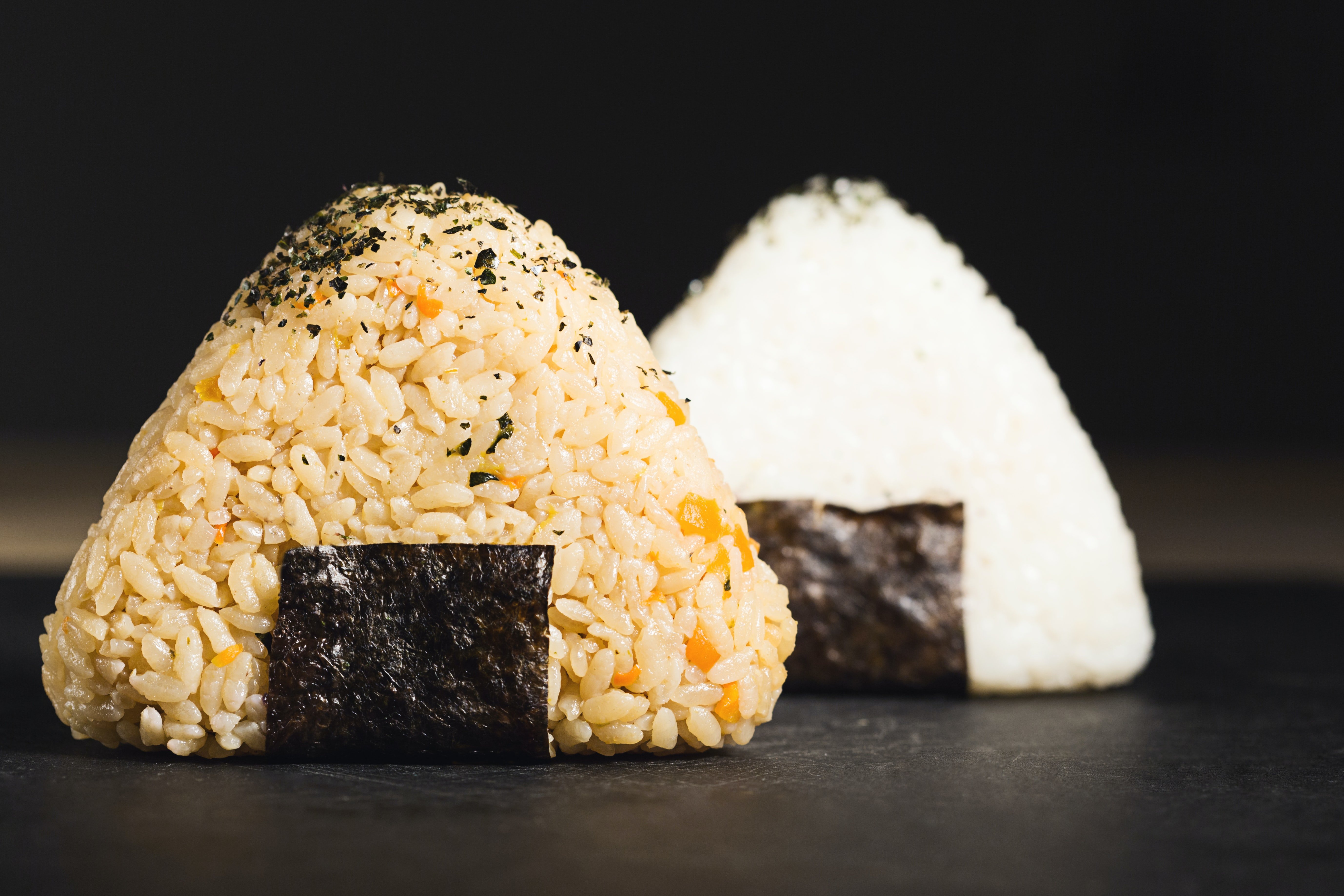Like many of the iconic Japanese foods that we love, onigiri is a mind-blowingly simple treat that takes a bit of practice to execute perfectly. After all, who would’ve thought that combining rice, nori, and a filling could be so challenging to get right?
If you’ve never had onigiri before, you can think of them as the sushi roll’s rustic, cooked cousin. But rather than rolling up seasoned rice, raw fish, and nori in a bamboo mat, to make onigiri you’ll shape cooked rice into a ball, press in a morsel of a non-raw filling, and perhaps wrap a strip of nori around this tasty package. They’re handheld, unsophisticated, delicious meals to go, ready to pack for a cold lunch or a picnic.
Onigiri consist of just a handful of elemental ingredients: cooked rice, nori, salt, maybe some seasonings like bonito flakes or toasted sesame seeds, and a seasoned filling. Your onigiri might just involve rice, salt and a filling, with nothing else. Because the ingredient list is so minimal, using high-quality wild-caught seafood as your filling is the way to go. As with a sushi roll, you want to use seafood whose qualities will truly elevate what is an otherwise bare bones, humble combination of ingredients.
Choose Your Rice
When making onigiri, you’ll have a lot of freedom with what you use as a filling, but you’ll need to be specific when it comes to the rice that you use. It’s the most important component of onigiri.
Short-grained white rice, aka sushi rice, is ideal to use for onigiri as it’s sticky enough to hold together. If you like the nutty flavor of brown rice, you could opt to use a short-grained brown rice instead, or a mix of brown and white, though you won’t be able to pack your onigiri into as tight a shape since brown rice isn’t quite as sticky. We recommend using white rice if you’re new to making onigiri — it’ll be the easiest to work with.
Follow the cooking directions for your rice of choice, then keep it someplace warm and covered until you’re ready to work with it.
Choose Your “Wrap”
A quintessential onigiri is wrapped with a strip of nori, which contrasts beautifully against white rice while also adding texture and flavor. When shopping for nori, you have your choice of pre-toasted or untoasted sheets. Opt for pre-toasted nori to keep things simple, and then cut a sheet of it lengthwise into four strips (they’ll be about an inch or so wide) so that they’re ready to use when you’re ready to wrap.
Instead of using nori, you could also use furikake to “wrap” your rice ball when it's finished. If you want to go this route, all you’ll need to do is have a small plate of furikake out so that you can roll your rice ball around in it to create a wrap-like layer of seasonings.
Can’t get your hands on nori or furikake? Go wrapless. The wrap part of onigiri is totally optional — though for some interest, you may want to add in some toasted sesame seeds to your rice before you roll it up into a ball.
Choose Your Filling
As for the filling, there’s really no limit to what you can use. Leftover flaked fish is a classic choice of filling, but smoked or cured bits of salmon would be nice to use too. One thing to consider, though, is that you’re only using a few morsels of seafood to fill your rice ball — so you’ll want to use something that’s adequately seasoned.
It doesn’t really matter how your seafood is seasoned, as long as you think it’ll go well with rice. Have a Moroccan-spiced halibut fillet leftover from a cookout? Or a roasted Captain Cut of sockeye that you seasoned with herbs de Provence? Flake those babies up and get ready to repurpose them for your onigiri. Depending on how big your onigiri are going to end up — they could be anywhere between 1/3 cup to 3/4 cup of rice — you probably won’t need more than two or three teaspoons’ worth of filling for each rice ball.
As an alternative to filling your onigiri, check out The Kitchn’s recipe, which skips the filling but mixes smoked salmon into the rice itself.
Basic Onigiri Technique
There are onigiri molds out there that will make getting the perfect shape a cinch, but the simplest, most lo-fi shape to make when you’re a onigiri beginner is a hand-formed ball.
To prevent the rice from sticking to your hands, keep a bowl of lightly salted water at your side. This will serve to add a bit of flavor to the exterior of your rice ball as well as to keep your hands moist enough that the rice won’t readily stick to them.
Fluff up your rice in its pot, adding in toasted sesame seeds or minced scallion if you like. Wet your hands in the bowl of salted water. While the rice is still warm, scoop up about a ½ cup of it into your palms and start forming it into a ball. You don’t want to smash the rice together by squeezing too hard. Just press the rice together firmly enough that it can hold its shape while allowing the individual grains of rice to retain their integrity.
Using one of your thumbs, make an indentation into the rice ball, then filling this space with your seafood. Close up this hole by pressing the rice together around it, packing the onigiri tightly now that it's nearing its final form.
To complete your onigiri, apply your wrap of choice, wrapping a strip of nori around the ball like a band (you may need to press it into the rice so that it sticks) or rolling the entire ball in a coating of furikake. Add another flourish of toasted sesame seeds or even a sprinkle togarashi, take a photo of your photogenic little meal, then enjoy your homemade onigiri on its own or with a side of soy.






